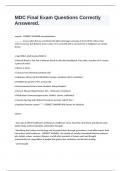Exam (elaborations)
MDC Final Exam Questions Correctly Answered.
- Course
- Institution
MDC Final Exam Questions Correctly Answered. myopia - CORRECT ANSWER nearsightedness _______ occurs when the eye overbends the light and images converge in front of the retina. Near vision is normal, but distance vision is poor. It is corrected with a concave lens in eyeglasses or contact len...
[Show more]



